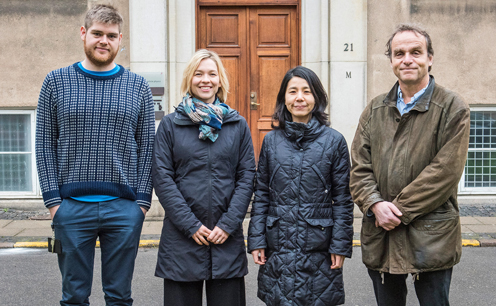Research Collaboration on virus attacks
Physicists and molecular biologists from the University of Copenhagen have published a new and exciting take on how bacteria can survive virus attacks. This result would not have been achieved, had the specialists confined themselves to each their own ‘ivory tower’.

From left: Physicist Rasmus Skytte Eriksen, NBI, molecular biologist Sine Lo Svenningsen, Department of Biology, and the physicist Namiko Mitarai and Kim Sneppen from the Biocomplexity group, Niels Bohr Institute.
Research collaborations reaching across the traditional boundaries in science provide us with an opportunity to view a problem in new ways by combining entirely different approaches. For more than ten years now, theoretical physicists and experimental biologists at the University of Copenhagen have benefitted from the expertise of one another and the collaboration has proved to be successful.
Future treatment methods on multiresistant bacteria
Between them, the researchers have found an explanation of how bacteria can coexist with aggressive viruses that prey on the bacteria and can kill them in less than an hour. If a lone bacterium is attacked by such a virus, it stands no chance of survival.
But the new results show that when many bacteria grow together in a dense colony, the outer layer of bacteria form a protective shield, absorbing the virus particles and protecting the core of the colony against the attack. The colony can then persist and grow from within, even though the surface bacteria are killed and produce even more viruses. This knowledge is necessary for evaluating future methods of treatment against multi-resistant bacteria, and increasing our understanding of human gut microflora (The microbiome) and much more.
Expert knowledge across traditional fields of research
As a student, Sine L. Svenningsen was encouraged by her professors to seek knowledge beyond her own specialty – and learn to interact with experts from across the traditional fields of research. Today, she tells her own students to do the same.
“As biologists, we wouldn’t have reached this result without the physicists’ expertise in taking spatial structures into account. It has always been a mystery why viruses don’t eliminate the susceptible bacteria. But now we see that the explanation can be as simple as the volume of bacteria growing together in a colony. If the colony is too small when attacked, it is eliminated, but if it has a sufficient volume, it can continue to grow although viruses are proliferating on its surface”, says Sine Lo Svenningsen, Associate Professor at the Department of Biology.
The bacterial survival strategy is analogous to that of a school of fish. Fish often travel in schools of enormous sizes, where predators are most likely to attack the fish in the rim, which gives the individual fish inside the school a higher chance of survival.
“It is an interesting kind of coexistence, where viruses proliferate on the surface of the colony, while bacteria grow in the core of the colony – both organisms keep increasing in numbers. The effect we describe, is already there in a microcolony, no more than a millimeter in size, which is easy to find in nature - also in the human gut. Our discovery could be one of the important mechanisms ensuring the coexistence of bacteria and the viruses attacking them, says Namiko Mitarai, Associate Professor at the Niels Bohr Institute.
The notion that a bacterial colony by sheer volume can provide protection from a viral attack was initially tested by the physicists with the aid of computer simulations. Then the group went to the laboratory to test if the idea would fly in reality. This approach could only happen through the combined effort of the two institutes.
The researchers are now examining other species of bacteria and other viruses to see if bacteria in general protect themselves by this type of shielding mechanism. If this is the case, the researchers hope to be able to better understand and control bacteria – and infections – in the future.
Contact
Sine Lo Svenningsen
Biomolecular sciences, Department of Biology
Tel: +45 3532 2033
Mail: sls@bio.ku.dk
Namiko Mitarai
Biocomplexity, Niels Bohr Institute
Tel: +45 5332 5402
Mail: mitarai@nbi.ku.dk
Kim Sneppen
Biocomplexity, Niels Bohr Institute
Tel: + 45 3532 5352
Mail: sneppen@nbi.ku.dk
Rasmus Skytte Eriksen
Biocomplexity, Niels Bohr Institute
Tel: +45 3532 5209
Mail: rasmus.skytte@nbi.ku.dk
Communication & Press
Helle Blæsild, Department of Biology
Tel: +45 2875 276, mail: kommunikation@bio.ku.dk
Søren Jønsson Granat, Niels Bohr Institute
Tel: +45 3532 0605, mail: granat@nbi.ku.dk
